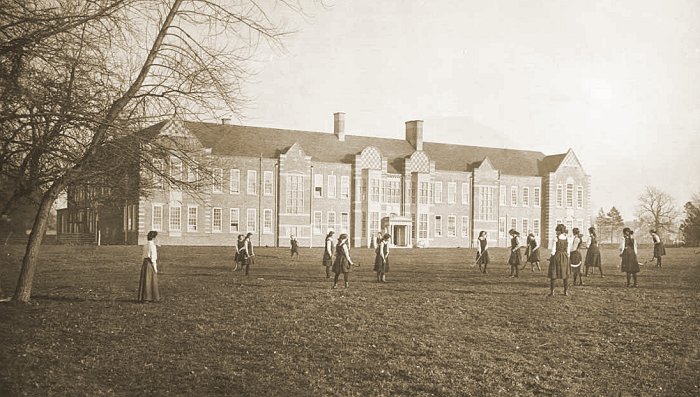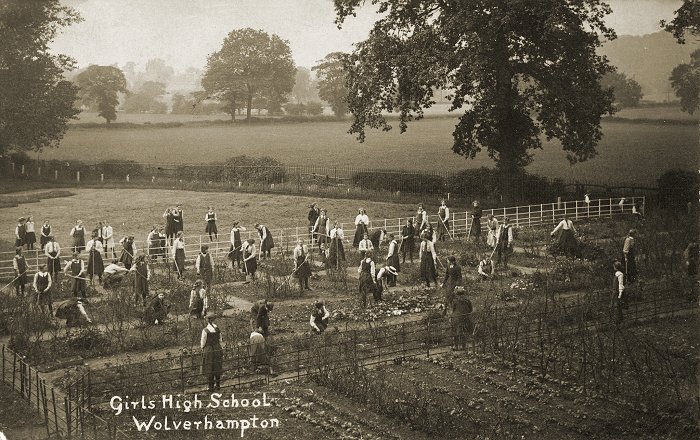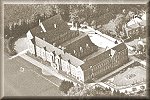|
 |
|
This is the story of one of Wolverhampton’s best schools. In
2014 and 2015 it outranked all other local secondary
schools. In January 2015 it came 25th in the national
ratings. Every pupil taking GCSEs achieved at least five A*
to C grades including English and Maths, and the school
achieved the highest number of A levels in the area.
Beginnings
The 1902 Education Act proposed by
Arthur James Balfour, and often called the Balfour Act,
greatly changed the administration of education at a local
level in England and Wales. It abolished the elected school
boards that had been established under the terms of W. E.
Forster’s 1870 Education Act, and replaced them with Local
Education Authorities (LEAs) under the control of the county
and county borough councils which had been established in
1888.
The Local Education Authorities were
given powers to establish new secondary and technical
schools as well as developing the existing system of
elementary schools. They maintained municipal or county
secondary schools, and provided grant-aid for grammar
schools.
In Wolverhampton, the Grammar School
provided advanced education for boys, but there was no
equivalent school for girls. Sound academic training was a
necessity for anyone wishing to go into teaching, because
the educational standards for pupil teachers had been
raised, and now required at least three years’ secondary
school work. The County Borough Council would not back the
Higher Grade School for this purpose, and so decided that a
Girls’ High School should be built. This was backed by the
County Council, and plans were made for a well built, but not
extravagant building, that could house around 400 pupils,
each costing the authority between £6 and £9 per year. There
was to be no religious requirement for the new school.
There would be a Board of Governors
consisting of seven people appointed by the Wolverhampton
Education Committee, seven people appointed by Staffordshire
Education Committee, and one person appointed by Birmingham
University. The people appointed by each education committee
had to include at least one woman. In 1909, the contract to
build the school was given to Henry Lovatt of Darlington
Street.
The new building cost £18,500 and had
two storeys. On the ground floor there were five classrooms,
an assembly hall, a physical laboratory, a lecture theatre,
a preparation room, and cookery and dining rooms. On the
first floor there were nine classrooms, a chemical
laboratory, a lecture theatre, a preparation room, an art
room, and a library. The school also had several acres of
playing fields. |

The school and playing field. From an old
postcard.
|
The first Years
The school opened in September 1911
with 180 pupils, and a kindergarten for five and six year
old boys and girls. The kindergarten was run by Miss Heatley
in a big room in the west wing, next to the gymnasium. The
last boys left in 1923 because space was needed for the
large number of girls seeking admission to the school. Half
of the pupils came from Wolverhampton, and half from
surrounding Staffordshire. From 1927 the number of pupils
from Staffordshire was reduced to one third. The fees,
payable on the first day of each term were as follows:
|
Preparatory Department
(pupils under the age of 7) – three guineas per
year.
Pupils over 7 and under 11 years of age – six
guineas per year.
Pupils over eleven years old – nine guineas per
year. |
Great attention was paid to physical
exercise including organised games in the open air, and
exercises in Swedish drill.
In 1913 the Board of Governors had the
following members:
Appointed by Staffordshire Education
Committee:
G. N. Adams, J.P.; Graham Balfour, M.A.; Rev. Preb. Dunkley;
James Legge; Miss Fry; J. T. Homer, J.P.; and one vacancy.
In 1914 the vacancy was filled by Lady Muriel Paget.
Appointed by Wolverhampton Education
Committee:
A. B. Bantock, J.P.; Watson Caldecott, M.A.; E. Deansley,
M.D., F.R.C.S., B.Sc.; Miss Hollings, M.A.;
L. Johnson,
J.P.; Miss B. Pearson, and C. T. Richards.
Appointed by Birmingham University:
Professor Alfred Hughes, M.A.
The teaching staff were as follows:
Head Mistress:
Miss Helen D. Heatley, M.A. (Lond.).
Assistant Mistresses:
Miss F. S. Clay; Miss A. H. Craven; Miss M. W. Dyott; Miss
M. E. Fletcher; Miss I. A. Irwin, B.A.;
Miss W. M. Kirkman;
Miss D. G. Leete, B.Sc.; Miss S. Luce, B.A.; Miss N. A. S.
O’Connor;
Miss M. E. Payton, B.A.; Miss K. M. Neligan, B.A.;
Miss K. L. Porcher, B.A.; Miss E. M. Stevenson;
Miss E. R.
St. C. Tissdall; Miss J. K. Wallis; Miss F. J. Leach, B.Sc.;
Miss E. A. Walton;
Miss D. Bailey, L.R.A.M.; and Miss H.
Jenks, L.R.A.M.
In 1914 Miss A. M. Baker; and Miss
Bexfield joined the staff, followed by Miss C. Buchanan,
B.Sc. in 1915.
Miss Helen Heatley, the school’s first
head mistress has been described by ex-pupils as having
great courtesy and consideration for others. She understood
the importance of carrying on with school traditions, and was
always sympathetic, kind and helpful. As head mistress she
had the important role of getting the school properly established before the
outbreak of the First World War. She lived nearby in Parkdale with her close friend and secretary, Miss Kirkman,
and tried to instil lady-like behaviour into the girls, who
were not allowed to walk down the drive without wearing
their hats and gloves.
During the First World War, efforts
were made to raise money for charities. The girls made
lavender bags, and collected sheep’s wool which was used to
make knitted squares. They were dyed in a wide range of
colours and sewn together to make blankets. Other items
included book markers, wall paper bead necklaces, and soft
cloth dolls. Allotments were also set up to produce fruit
and vegetables.
On 11th November, 1918, Miss Heatley
summoned the whole school to the hall to inform them that
the war had ended, and the armistice had been signed.
Everyone was then sent home for the rest of the day.
Miss Heatley was well liked and
respected at the school. She left in 1921 but sadly died
four years later. She is remembered at the school thanks to
the Miss Heatley Memorial that was placed in the hall, and
through the Heatley Memorial Fund, a registered charity set
up by the school to make grants to individuals. |

Tending allotments. From an old postcard.
Courtesy of Ralph Hickman.
|
A New Head Mistress
In 1921 the school had a new
headmistress, Miss D. E. de Zouche, M.A. who had been a
scholar at Somerville College, Oxford. She had a logical
mind and good organisational skills. She could quickly get
to the heart of any argument, and express her views
pointedly and if necessary, tersely. She quickly made a mark
on her profession when she became a member of the
Association of Headmistresses in 1921 and performed much
valuable work on behalf of the Association, eventually
becoming its President. She sat on many of the Association’s
committees, and made a valuable contribution to her
profession.
During her reign the number of pupils
rapidly increased. At the beginning of the school year in
1924 there were 427 pupils, paying an annual fee of £12. If
two sisters were at the school, their combined fee was
reduced to £21. By 1929 there were 440 pupils, and in 1934
there were 484 pupils.
From 1927, two thirds of the pupils
were selected from Wolverhampton, and one third from
surrounding Staffordshire. The local Education
Committee then elected ten of the sixteen School Governors, and
Staffordshire Education Committee elected five. The
remaining one was still elected by Birmingham University.
In the 1920s there were school trips to
London to visit art exhibitions, and to Rhyl, starting
in the middle of the night to view the total eclipse of the
sun. There were also outings to Port Sunlight, and to
Cadbury’s at Bournville. In the early 1930s a group of girls
travelled to Dorset with Miss Southam.
School Worship
Each school day began with an act of
worship. There would be school prayers, a hymn, and a
scripture reading, often based on a topic or theme that was
suggested by the girls themselves. Most forms would
volunteer to take their turn in the
week’s worship. They supplied a pianist, a reader,
chose the hymns and prayers, and the reading to fit their
particular theme.
There were also house prayers carried
out by each house, usually in the gymnasium, under the direction of
the house mistress and the senior girls. Afterwards, notices
concerning the house would be given out, and badges could be
given to house officers.
Twice a year the whole school would
meet for a special service, the first being at the beginning
of the year, and the second for the harvest festival. On
each occasion a talk would be given by a member of the
Wolverhampton clergy. In some years a service for school
leavers was held in St. Mark’s Church. |
 |
|
 |
Return to
the articles menu |
|
Proceed to
part two |
|